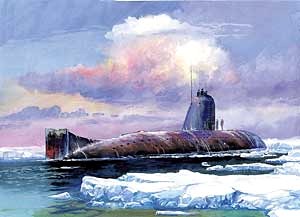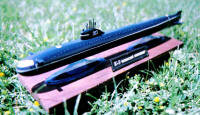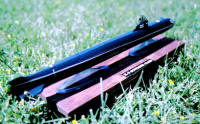|
Zvezda Models 1/350 K-3 November Class Nuclear Submarine |
|
|
Kit Number 9035 |
|
|
Reviewed By Mark Andrews, #33206 |
|
|
|
|
|
MSRP: $20.95 USD Parts: 34 Injection Plastic, Decals K-3 was project 627 ("kit," meaning "whale"; NATO reporting name "November") submarine of the Soviet Navy's Northern Fleet, the first nuclear submarine of the Soviet Union. The first of the class was the Leninskiy Komsomol, or simply K3. She was built in Molotovsk, launched on 9 August 1957, commissioned in July 1958, and home ported at Zapadnaya Litsa on the Kola Peninsula. It was the first submarine of the Soviet fleet to navigate to and surface at the North Pole. She was armed with both conventional and nuclear tipped torpedoes. The November class boats were plagued with reactor problems and several reactor accidents occurred while on patrol. K3 has been preserved as a memorial to the lost crews. The remaining survivors are now radioactive hulks in Russian ports. This all new tooled Soviet Navy submarine comes from the Russian model company Zvezda. Molded in black plastic, the parts are crisply molded with fine recessed details. Kit comes with two sails, one for the modified 627A that had a slightly taller sail. It also has the sonar bulge under the forward hull. All of the other parts are the same for both versions. Unfortunately typical of Zvezda kits the parts are not bagged and the parts move very freely in the box. Fortunately none of my parts are broken or badly scratched. The instructions are broken into 4 major steps with the decal placements called out on the last page on a one-view drawing. There are decals for two 627 versions and one 627A. No history is given for the different hull numbers or versions. Most of the instructions are in Russian with some painting instructions in English. The sheet does give Testors Model Master paint numbers. Decals look crisp and they do include the white water demarcation line, something that has been neglected on earlier Zvezda releases. The parts are molded in dark blue and show very little flash. Detail is engraved and very well done. Time for building! The hull sides and the two piece deck are the first to be assembled. All the parts go together very well with just a bit of filler needed for the hull seam. The deck fits tight and flush with the hull top. You need to open the two holes for the two piece display stand. The next is the sail and all of itís details. There are two complete sails and no explanation of the difference. I am building the 627 version as this I believe is the original configuration. The sail goes together well with all of the masts and periscopes. I inserted the small parts in the top of the sail with a touch of liquid cement. Then I ran a bead of thick super glue along the bottom of the parts though the bottom of the sail. This should keep the parts from coming off. Next I installed the sail, the rear diving planes and the fore planes. All the parts went on with no problems. I left off the screws until after painting, decaling and final clear coating. I painted the sub in overall Testors Acryl Dark Sea Blue. This had enough gloss to it that I didnít need a gloss coat before decals. The decals thin and opaque. Much improved from Zvezdaís earlier releases. The waterline is a multiple piece affair and goes on nicely. There is a bit of extra that will need to be trimmed but that is better than too short! The decals responded well to the Microscale decal solvent system. The only one I had some issues with was the silver decal for the upper front of the hull. It kept wanting to wrinkle and not lay totally flat. I did use a knife to try to get some of the folds out and help with getting more solvent under the decal. It helped but it still did not turn out the way I wanted. After the markings were on I used some black wash for the recessed details. The final clear coat is the Testors Semi-Gloss laquer. The screws were installed last. My only real beef with this kit is the Zvezda trademark oval shaped display stands. They do not provide enough ballast to keep the model from tipping over. You could put some weight in them but since these are clear blue, you will need to paint them if you choose this method. The best alternative might be building your own stand. This is a decent sized model and not much would be needed to tip this thing over. But overall this is a good kit with decent detail of a needed subject from the other side of the Iron Curtain! Additional Reference: Warships Today, Chris Chant, 2004, Summertime Publishing/ Barnes and Noble Books, New York |
|
|
Information, images, and all other items placed electronically on this site are the intellectual property of IPMS/USA ģ. |
|



